BASE3 For Agencies
Reduce client confusion and dozens of hours of labor by using the BASE3 model to inform and guide your digital marketing recommendations.
Visually inform your clients of the strategy behind your recommendations.
Present measurable datapoints to support your tactics.
Have a cross-functional tool that informs all stakeholders of their role in the customer’s buying journey.
How to use BASE with your clients
1. Initial Consultation:
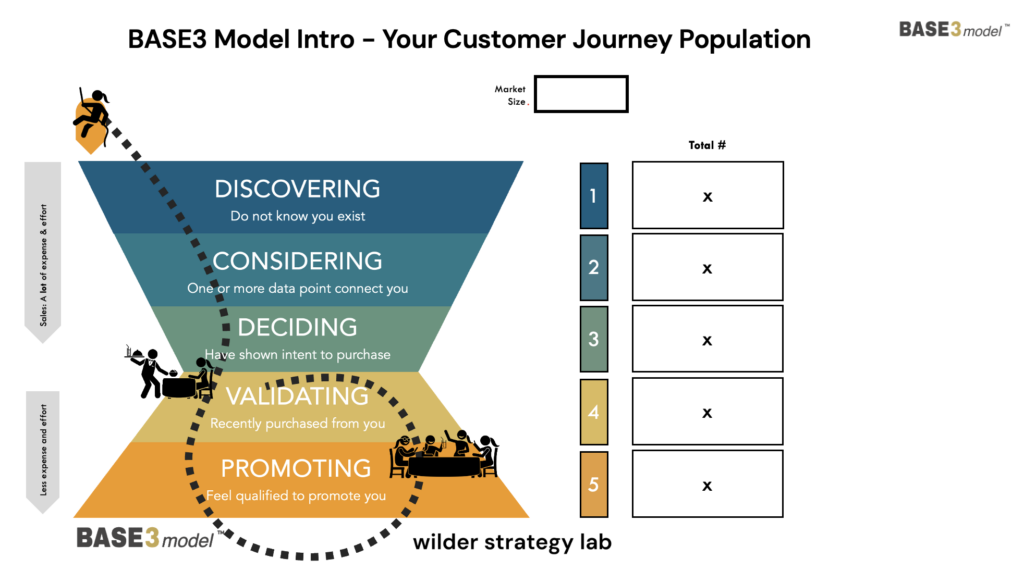
2. Project Assessment
Include in your assessment a review of each of the channels. Highlight those that are missing, and shade out those that they can ignore. In your project assessment, answer the following questions:
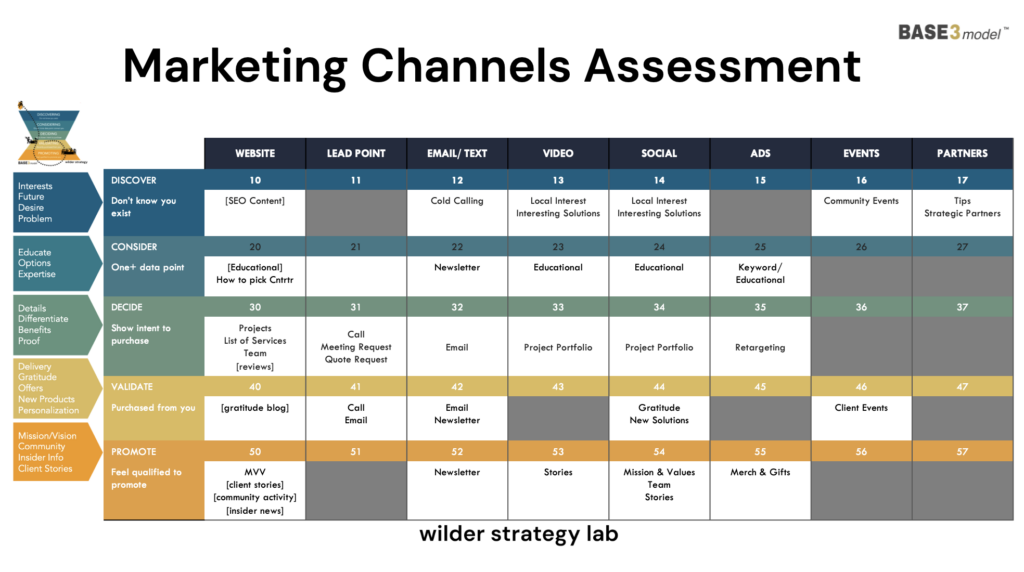
3. Content Themes
Include a table showing examples of content topics that are relevant for their customer’s journey.
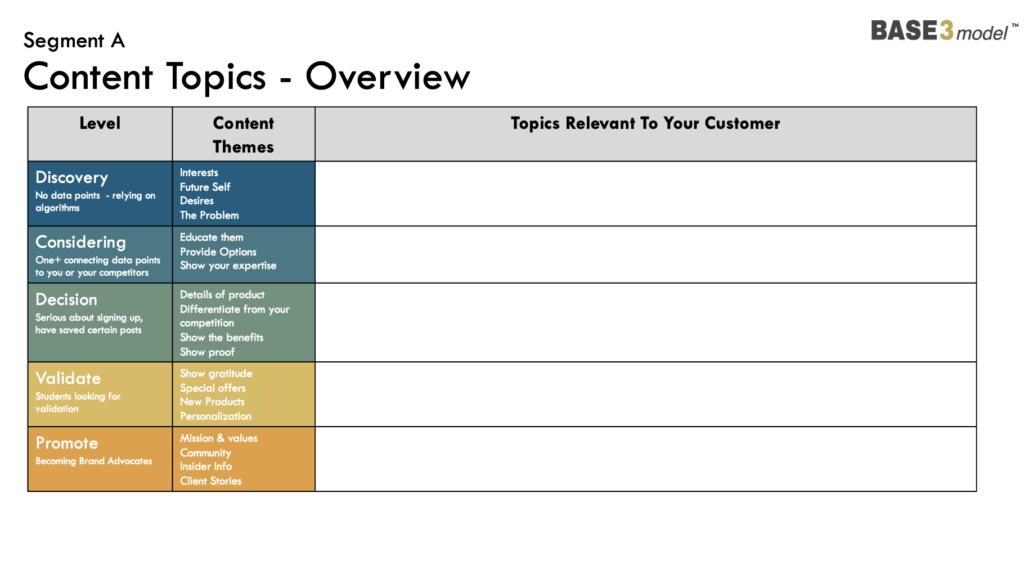
4. Scope of Work – Build The System
When implementing BASE3, you will usually find that the client needs one or two or more additional tools such as a CRM to make data collection possible for the different journey levels. Your Scope of Work should include two parts.
Section I: Building The System – Create Missing Touchpoints/Channels
Section II: Plot campaigns needed for each level.

5. Scope of Work – The Campaigns
You will likely be creating multiple campaigns and will have a different chart for each.
Use a table to identify the channel numbers, with important corresponding inforamtion such as the platform, A description, what the call-to-action is or engagement goal, what assets are needed, and who owns the channel production.
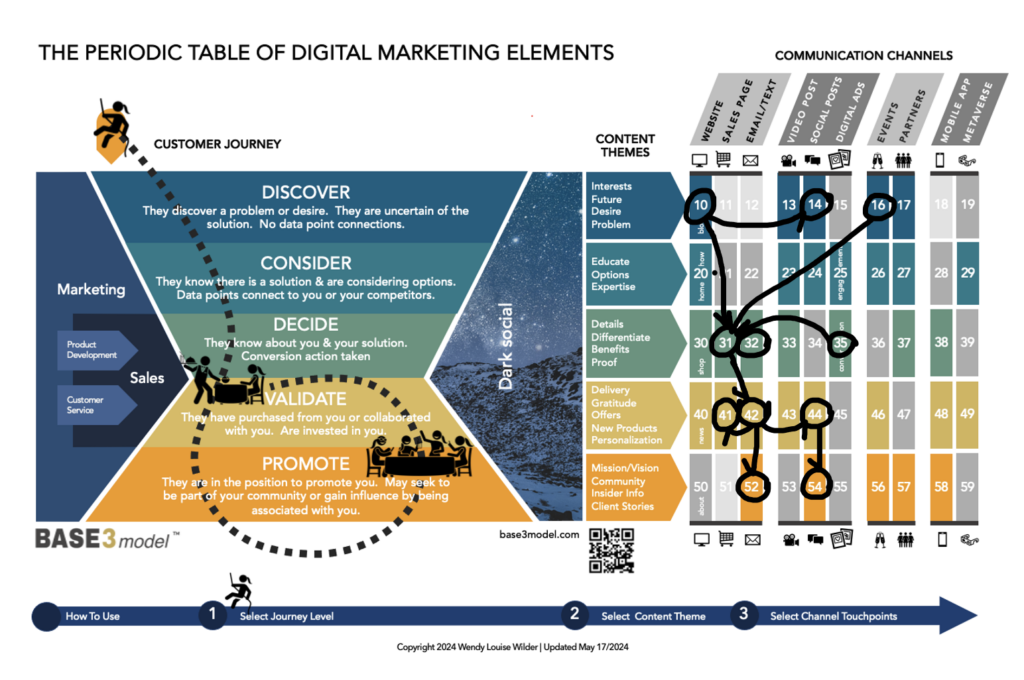
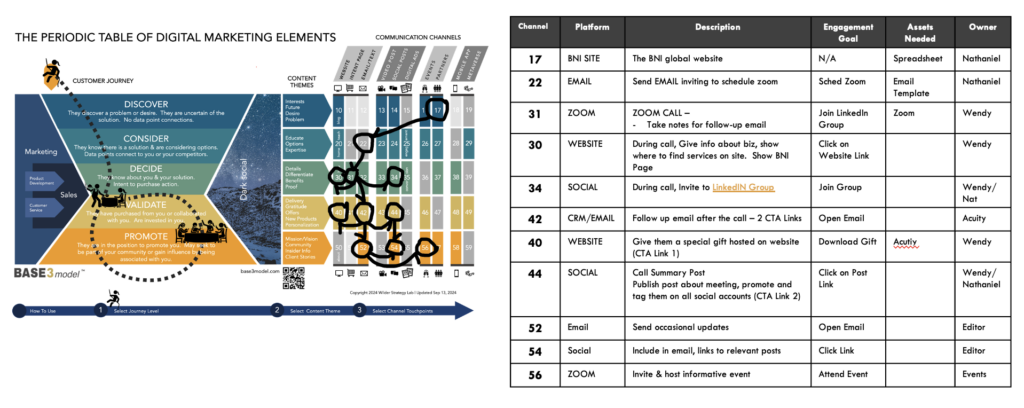
How To Access BASE3 For Your Agency
Option 1: Learn Through Implementation.
Full Service Consulting
Experience a BASE3 implementation in your agency with our full service BASE3 consulting. Going through the process internally will align your process with BASE3 and give you visibility into how your clients will experience BASE3.
Option 2: Guest BASE3 Project Consultant
We can provide you with a BASE3 consultant to walk your team and a client through the BASE3 Process
Option 3: Self-Guided Online Courses
Take our self-guided Colored Belt courses to learn BASE3 at your own pace.

Benefits of using the BASE3 model
A marketing director using the BASE3 model gains distinct advantages in addressing two critical concerns: demonstrating marketing ROI to business owners and effectively leading a diverse team of creative and technical professionals. Here’s how the BASE3 model helps:
1. Demonstrating Marketing ROI to Business Owners
Strategic Alignment with Business Goals
- BASE3 ensures that marketing efforts are explicitly tied to business objectives, such as revenue growth, lead generation, or brand awareness.
- Instead of just reporting website traffic or click through rates, the marketing director can show how those visitors move along their decision-making process and convert into leads, sales, or other tangible outcomes aligned with the owner’s goals.
Data-Driven Reporting
- The BASE3 model emphasizes tracking KPIs and outcomes to measure campaign performance and ROI.
- A marketing director can present dashboards showing the cost per lead, customer acquisition costs, and revenue generated from specific campaigns, providing clear evidence of marketing’s impact on the bottom line.
Clear Attribution
- The framework includes tools and methods for attributing results to specific marketing activities, eliminating ambiguity.
- Using BASE3 principles, the director can demonstrate how a paid search campaign directly influenced sales or how an email sequence nurtured leads into customers.
Building Credibility
- Business owners gain confidence in marketing when shown a structured approach with transparent results.
- Presenting a quarterly BASE3-based performance review that shows progress toward strategic goals reassures owners of marketing’s value and direction.
2. Leading a Team of Creative and Technical Professionals
Clear Vision and Direction
- BASE3 ensures all team members understand the overarching strategy, fostering alignment between creative ideas and technical execution.
- A marketing director can guide a campaign by outlining the strategic goal (e.g., increase signups by 20%) and let the team innovate within those boundaries.
Role Clarity
- The model defines roles and responsibilities, helping creative and technical members work cohesively.
- Designers focus on visuals, writers on messaging, and developers on implementation, all contributing to a unified campaign.
Encouraging Collaboration
- BASE3 promotes cross-functional collaboration, ensuring creative and technical teams work in harmony.
- Hosting joint brainstorming sessions where technical insights inform creative ideas (e.g., mobile-friendly designs for an ad campaign).
Balancing Creativity and Strategy
- The framework fosters creativity while keeping it aligned with measurable goals.
- A marketing director can encourage out-of-the-box ideas but evaluate them against the strategic objective, ensuring they’re not just flashy but effective.
Streamlined Processes
- BASE3 introduces systems for smooth project management, reducing friction between teams.
- Using agile sprints or task management tools based on BASE3 principles helps track progress, meet deadlines, and ensure quality.
Motivating Team Members
- The model’s clarity on strategy and purpose inspires team members, as they see how their work contributes to larger goals.
- Celebrating milestones like achieving a lead-generation target reinforces the team’s impact and boosts morale.
Resolving Creative vs. Technical Tensions
- BASE3 bridges gaps between creative and technical mindsets by emphasizing shared goals.
- If a creative concept is technically challenging, the director can mediate by prioritizing core objectives and finding a solution that satisfies both perspectives.
Why This Matters for a Marketing Director
- In reporting to the Business Owner: BASE3 empowers the director to communicate marketing’s value in terms of tangible business outcomes. With clear metrics and reports, the owner sees how marketing contributes to profitability and growth.
- In leading the Team: The director becomes a unifying force, fostering collaboration and innovation while maintaining focus on strategic goals. This leads to a high-performing team that delivers impactful campaigns.
Summary
In summary, the BASE3 model helps a marketing director address these concerns by providing the tools to showcase ROI with clarity and lead a team effectively through collaboration, strategic alignment, and clear communication. This dual focus makes marketing more credible to owners and more cohesive and fulfilling for team members.
How to use the chart for documentation and for collaborating with your team.
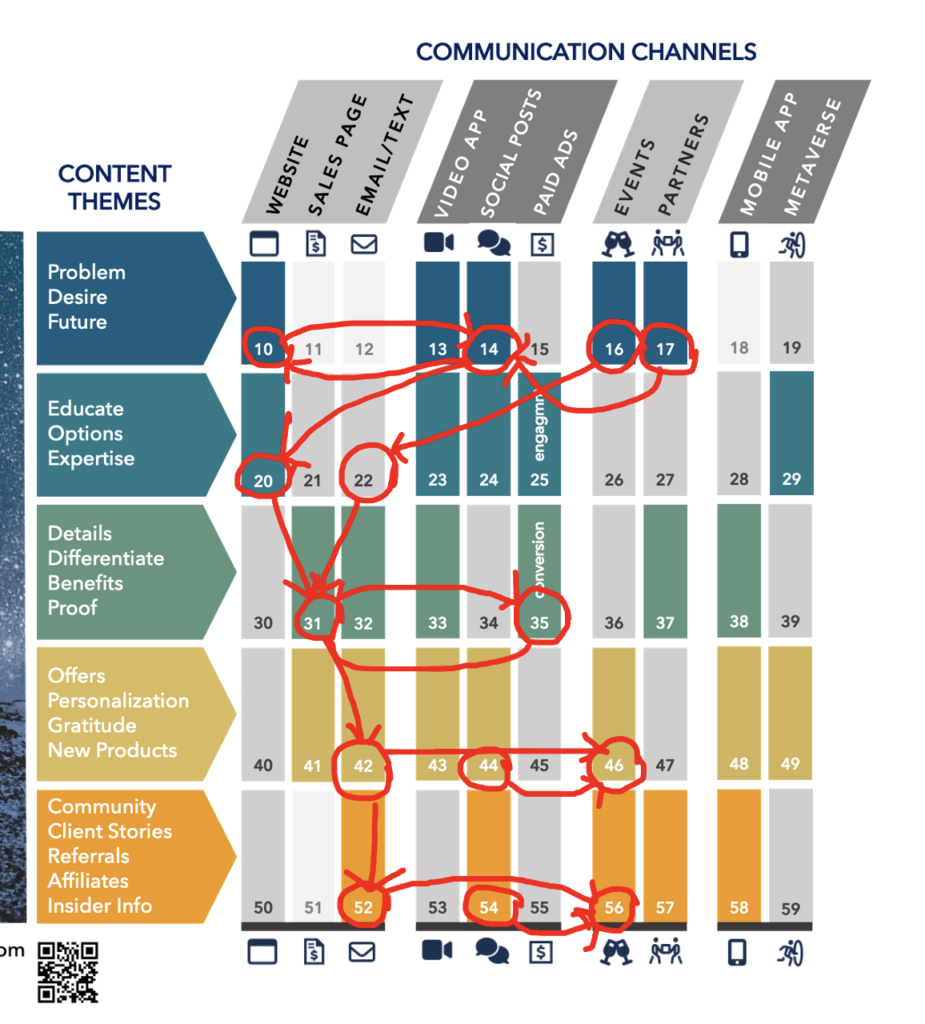
Use In Documentation
By sharing the visual diagram of a campaign with your team members, they will understand how their creative, writing, or technical work fits into the larger campaign.
The Communication Channels are numbered so that each can be added to your documentation.
Each channel will have a set of production tasks that are needed for completion.
As you begin to use the chart frequently, you will find that you use some of the same channels often in campaigns, and you can create templates for the to-do lists.
Below is a simplified example of to-do items for Channel 10, which is blog articles for customers in the early awareness level of their journey.

Two big challenges digital marketers have are explaining to stakeholders the reasoning behind the work that they do, and identifying the data to support it. This is because there has not been a standardized method for doing so. BASE3 solves both of these challenges.
The BASE3model ™ is represented by a visual chart called “The Periodic Table of Digital Marketing Elements.” The elements on the chart create a structure around the customer’s decision-making process. A numbered channel grid on the chart makes it possible to map out the customer’s journey. Each channel has a data point that can be reported.
By diagraming out a campaign visually, the stakeholders can see how the customer is guided along their journey from discovery to becoming a customer and then an advocate for the brand. It is also then possible to understand what systems and technology are need to be in place to support that journey and which data points to watch.